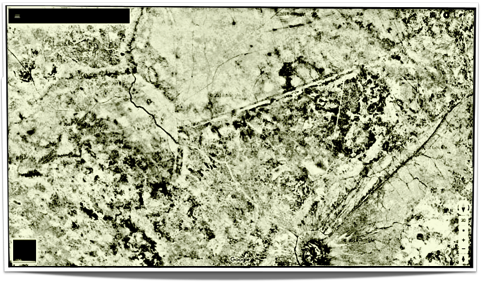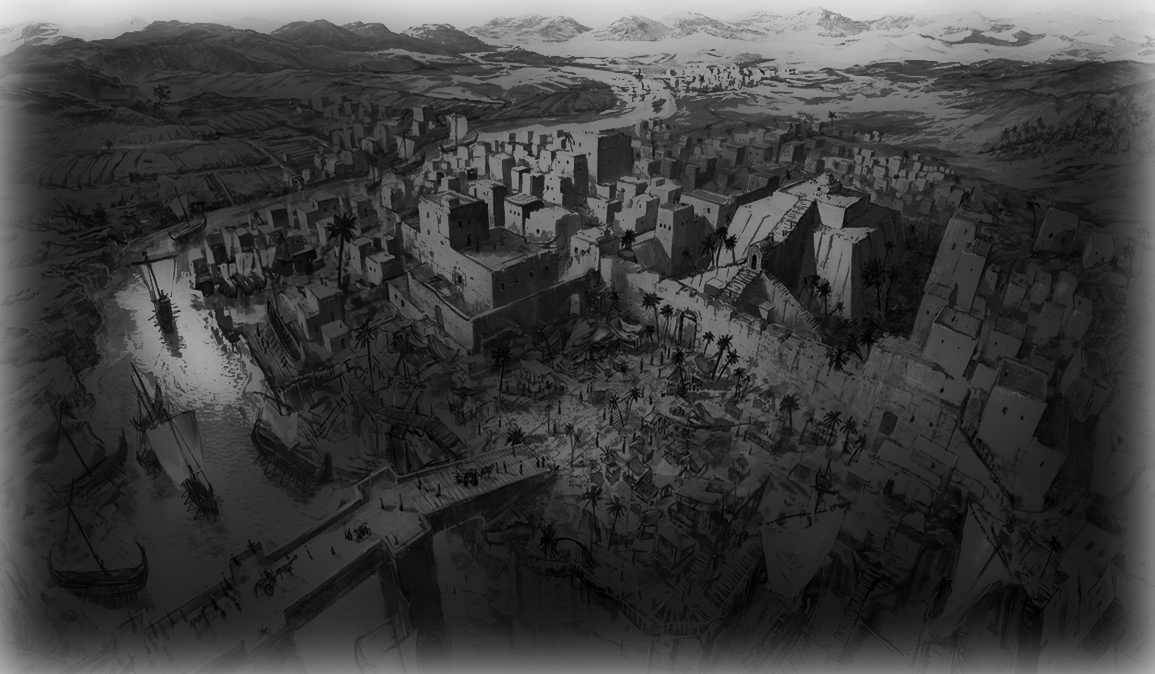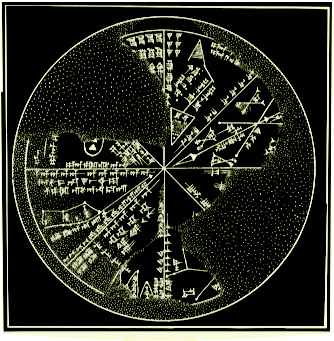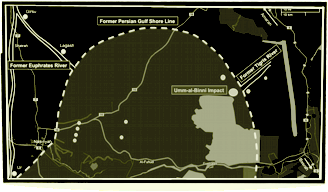

|
The Lost City of Akkad
The disappearance of early civilizations by a major meteor impact?
|
| The Project | The Research |
| THE PROJECT |
| This project wants to find out if 4200 years ago in 'Eden' in Iraq, there was a comet impact that unleashed the power of 9400 Hiroshima bombs. On satellite images we found a structure in the dried-out wetlands that points to a cosmic impact. There's a crater shaped lake. We have a gravitational map that supports a comet impact. And a few miles from there, outlines can be seen in the desert sands that look like an ancient port city. And the 4200 year old clay tablet K8538 describes the whole event. |

|
|
Our Iraq Expedition has three objectives.
OBJECTIVE 1: Verify a comet impact site in Mesopotamia.
Implications: A verified bolide impact in Iraq at around 2193 BCE would be huge news. According to climate research carried out by Seifert and Lemke it could even be the cause of the 4.2 kYear Event. That event caused the collapse of the old Egyptian Kingdom and the Akkadian Empire, the Liangzhu culture in China and the Indus valley civilization.
OBJECTIVE 2: Verify information from the old Sumerian tablet K8538 as first ever written eyewitness account of a cosmic impact. We see the clay tablet K8538 as a late Babylonian copy of a much older Sumerian original. K8538 was interpreted as a report on God's omnipotence and power of destruction and copied over a timespan of thousands of years because of it's importance. In other words, K8538 was regarded as the direct word of (or from) God.
Implications: We hypothesize K8538 as being the source for the tales of Genesis (Tower of Babel, the Flood, Sodom and Gomorrah, the parting of the Red Sea, the Egyptian plagues, Exodus). Copies of the tablet may have been kept in various places, such as libraries and wooden arks.
OBJECTIVE 3: Investigate nearby unidentified structures (may be related to the lost city of Akkad). Any newly discovered ancient structure is always great news.
Implications: The sudden disappearance of Akkad has puzzled archaeologists for many decades. A comet or meteorite impact in it's vicinity would certainly explain it's sudden vanishing act. If the visible structures do not belong to Akkad, they are also of archaeological significance, but not on the scale of the World Sensation this find would otherwise be. |
| THE RESEARCH |
|
By Joachim Seifert and Frank Lemke
Published: April 25, 2014 |

|
|
Abstract
The K8538 is the world's first scientific documentation on approach and terrestrial impact of a large comet on Earth.
Observations were made on top of an astronomical tower, located 100 km close to the impact site. The report is presented in form
of a sequence of eight pictures, explaining the comet's first astronomical sighting, the appearance of comet tail and coma,
the growing comet size, the comet flight across the sky and finally, its visible impact beyond the horizon, i.e. the impact
flash lighting of the sky and the subsequent elevation of ash plumes, glowing beyond the horizon, spreading North and West.
The impact itself is not described as a blast pressure wave but rather as an ash and dust tempest, rising out of mud sediments
from the Tigris and Euphrates river delta, where the hot comet found its burial. The astronomical observer carried out
trigonometrical measurements to record the flight path in the sky, flying distances and flying times. The observer started
his measurements as soon as the comet showed its spectacular size, coma and tail, which convinced the observer, that an
extraordinary celestial event was about to take place. The K8538 is a full comprehensive analysis of the comet event; its
eight-picture sequence is cohesive. The tablet is a masterly work, explaining with as little text a maximum amount of impact
event features. The tablet is a late Babylonian copy of the early old Sumerian original. Written cuneiform signs of two zodiacal
constellations, Orion and Triangulum, are later Babylonian copy scribe additions and were not part of the Sumerian original.
The K8538 tablet had high priority in Babylonian times, because it provided the documented evidence that the comet emerged out
of the constellation Triangulum, Mul-Apin, onto which late Babylonian astronomy and religion rested. The tablet eyewitness
account shows Mul-Apin as celestial seat of Gods and celestial source of destructive meteors on Earth. For this reason, the
K8538 was guarded, copied and refreshed over more than 1,500 years, until the late Babylonian period, after the observed meteor
impact in 2,193 BC. The tablet does not deal with any Babylonian zodiacal astrology. The described cosmic impact on Earth is the
so-called 4.2 kyr event, shown in our other Holocene climate change studies. The comet impact is responsible for a 300 year long
drop in global temperatures combined with lasting mega-droughts, which led to the collapse of various ancient civilizations around the world.
|
|
By Joachim Seifert and Frank Lemke
Published: February 19, 2019 |

|
|
Abstract
The paper adds new translation knowledge to our 2014 paper: “The Sumerian K8538 tablet, the great meteor impact devastating Mesopotamia”. We present an improved, detailed fixing of the meteor impact day and impact hour, according to data provided on the tablet. A sky map for Northern Taurids meteor showers shows the comet flight path in the sky. Other useful information is given concerning climatic change, following the meteor impact, the meteor impact aftermath and new details for the relation of the cosmic impact to the Christian Bible, in particularly to Genesis and Apocalypse. The meteor impact occurred at 10:56 am, on September 22, 2193 BC, after the meteor emerged at 5:34 am at dawn and after a flight time of 5 hours 22 minutes. These numbers can clearly be deduced out of observation data entries in the tablet’s pictographic records and in comparison to LOD (length-of-day tables) for the corresponding Mesopotamian latitude. The K8538 tablet is property of the British Museum. Unfortunately, the museum is staunched in its opinion that this tablet represents the Babylonian sky as a so-called “planisphere”. This opinion is based on an interpretation, which we, for the first time, analyze in comprehensive detail, item by item, in this paper. Result: The planispheric concept of the Babylonian sky on this tablet is a hoax: Not one single correct argument proves alleged recorded planispheric constellations on the tablet, except one, already found by L. W. King, over 100 years ago, back in 1912. As translated in our 2014 K8538 paper, the tablet has never been a planisphere, but is a pictographic “cartoon” story, probably the first recorded cartoon of the world, consisting of a sequence of 8 subsequent pictures, to be turned while reading, to advance the story. All 8 pictures exclusively show observations, recorded measurements and specific details of flight and impact of this disastrous meteor, which destroyed the nearby Akkadian capital in Mesopotamia. Because Southern Iraq in the impact area was swamp and marshland until recently, an exploration of the discovered impact crater, Umm-al-Binni, was impossible. For the first time, it is feasible from 2019 on, and a first crater inspection will soon be conducted. Due to missing explorations of the impact crater, Near-East historians, until now, did not recognize the historical cosmic impact event, but we may expect that this will change in the near future.
|
|
By Joachim Seifert and Frank Lemke
Published: May 15, 2013 |

|
|
Abstract
We focus on one of the most important events in human history, the 4.2 kiloyear event, when great civilizations around the world collapsed
into anarchy and social chaos. From this moment on, climate cooling and widespread aridification began, lowering agricultural food production and human
living conditions. Various hypotheses exist about its cause; the most promising approach links the 4.2 kiloyear event to a cosmic asteroid crash into
Mesopotamia. The asteroid landed in a densely populated area; we examine at first major translations of preserved Sumerian documents on details and
progression of this catastrophic event. We quote major impact features as observed by historical Sumerian eyewitnesses. The impact, as a full strike,
eradicated the Imperial city of Akkad. The impact damaged all other Sumerian towns to different degrees. Based on our findings, we identify the location
of the missing city of Akkad. We analyze the onset of global cooling and severe aridification in the framework of our cosmic climate footprint analysis
for a selected 1,000 year timeframe. This footprint analysis of Holocene climate change affirms the occurrence and date of the impact event. We also
identify volcanic mega-eruptions, which are responsible for multi-decadal global temperature dips but which cannot cause centennial-long climate changes.
The footprint analysis takes 5 climate macroforcings into account and explains global cooling and aridification based on impact-related causes.
|